Definition For Range Of Motion
Introduction [edit | edit source]
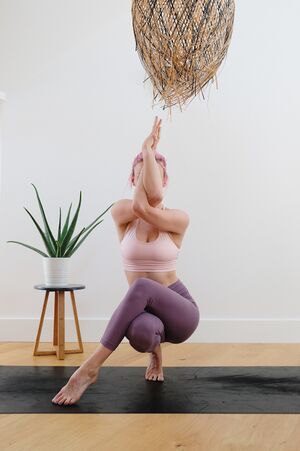
Range of motion (ROM) is the capability of a articulation to go through its complete spectrum of movements. Range of motion of a articulation can be passive or agile.
Definition - The definition of ROM varies among published sources; Kapandji and colleagues described ROM equally "the extent of osteo-kinematic motion available for motion activities, functional or otherwise, with or without help" [i]
- Passive range of motion tin be divers as the range of motion that is achieved when an outside forcefulness (such as a therapist) causes motion of a joint and is ordinarily the maximum range of motion that a joint tin motion.
- Active range of motion is the range of motion that can be accomplished when opposing muscles contract and relax, resulting in joint movement. For instance, the active range of motion to let the elbow to bend requires the biceps to contract while the triceps muscle relaxes. Active range of motion is commonly less than passive range of motion.
Range of motion therapy is beneficial in healing and in recovery from soft tissue and joint lesions, maintaining existing joint and soft tissue mobility, minimizing the effects of contracture formation, profitable neuromuscular reeducation, and enhancing synovial move[ii].
Measuring Range of Motion [edit | edit source]
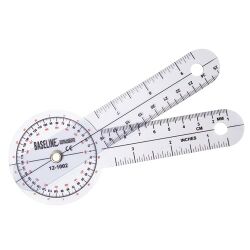
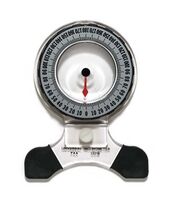
A Goniometer is used to measure range of move of the joints of the torso. It uses a stationary arm, fulcrum, and movement arm to measure articulation angles from the axis of the articulation.[3]
Of all the types, a universal goniometer is most widely used and comes in two forms: short arm and long arm.
- The curt arm goniometer is used for smaller joints like the wrist, elbow, or talocrural joint,
- The long arm goniometers are more accurate for joints with long levers like the knee and hip joints [4]
See the goniometry drove of pages for instructions on how to correctly (reliably and accurately) place the goniometer when measuring range of motion.
An Inclinometer tin can also be used, which has different purpose. It is non every bit versatile as a goniometer.
Record measures tin too exist used to mensurate range of movement in some specific parts of the body (lumbar spine range of motion).
Motion Planes [edit | edit source]
When considering the range of motion of a joint, or the motility direction, there are three universal planes that demand to be taken into business relationship. Each of the movements prevarication in one of the respective planes. [five]
| Plane | Division of plane and centrality | Axis of Rotation | Movements |
|---|---|---|---|
| Frontal (coronal) | Divides body or segment into inductive or posterior sections | Sagittal | Abduction and adduction |
| Sagittal | Divides body or segment into left and right sections, which is referred to as medial and lateral sections | Frontal (transverse) | Flexion and Extension |
| Transverse | Divides trunk or segment into to and bottom, or upper and lower sections, which is also referred to as superior and inferior | Longitudinal (vertical) | Internal Rotation and External Rotation |
Range of Motion Normal Values [edit | edit source]
Each joint has a normal ROM range of values, while each person has a different corporeality of ability to attain it. Below are generally accepted values for a normal ROM for some private joints equally measured in degrees:
| Joint / Segment | Motility | Degrees |
|---|---|---|
| Wrist | Flexion | lx |
| Extension | sixty | |
| Radial Difference | 20 | |
| Ulnar Deviation | 20 | |
| Forearm | Pronation | 80 |
| Supination | 80 | |
| Elbow | Flexion | 140 |
| Extension | 0 | |
| Shoulder | Flexion | 180 |
| Hyperextension | 50 | |
| Abduction | 180 | |
| Adduction | 50 | |
| Shoulder with Abducted Arm | Internal Rotation | 90 |
| External Rotation | ninety | |
| Horizontal Adduction | - | |
| Horizontal Adduction | - | |
| Cervical Spine | Flexion | 60 |
| Hyperextension | 75 | |
| Lateral Flexion | 45 | |
| Rotation | 80 | |
| Thorac0-Lumbar Spine | Flexion | 45-l |
| Hyperextension | 25 | |
| Lateral Flexion | 25 | |
| Rotation | 30 | |
| Hip | Flexion | 100 |
| Hyperextension | 30 | |
| Abduction | 40 | |
| Adduction | 20 | |
| Internal Rotation | xl | |
| External Rotation | 50 | |
| Knee | Flexion | 150 |
| Extension | 0 | |
| Talocrural joint | Plantarflexion | 40 |
| Dorsiflexion | 30 |
Causes of Express Range of Movement [edit | edit source]
Limited range of motion refers to a joint that has a reduction in its ability to move. Motion may exist limited because of a problem within the joint, swelling of tissue around the joint, stiffness of the muscles, or hurting.[7]
Medical conditions associated with a limited range of motion in the joints include:
- Ankylosing Spondylitis
- Osteoarthritis (OA)
- Rheumatoid Arthritis (RA)
- Juvenile RA, which is an autoimmune grade of arthritis that occurs in children under the age of 16 years
- Cognitive Palsy (CP)
- Legg-Calve-Perthes disease.
- Sepsis of the hip and other joints, which is a bacterial infection of the joints
- Built Torticollis
- Syphilis, which is a sexually transmitted infection (STI)
Other causes of restricted range of motion include:
- Inflammation of the soft tissues surrounding the joint, or joint swelling
- Musculus Stiffness
- Pain
- Joint Dislocation
- Fractures [8]
Other than pathological causes for restriction of movement, in that location could exist non-pathological causes such as
- Tight Clothing
- Hypertrophy of muscles due to strength training (e.g biceps brachii hypertrophy limits the range of elbow flexion)
Increasing Range of Motion [edit | edit source]
As mentioned in the next department, range of motility can be maintained and gradually increased through the post-obit range of move & stretching exercises. Check out the folio on Stretching for an in-depth explanation of the concept and topic.
Range of Motion Exercises & Stretching [edit | edit source]
Range of move exercise refers to activeness aimed at improving movement of a specific articulation. This motion is influenced by several structures: configuration of bone surfaces inside the joint, articulation capsule, ligaments, tendons, and muscles acting on the articulation.
There are three types of range of move stretching exercises:
- Active Range of Motion: Move of a joint provided entirely by the individual performing the practise. In this example, there is no outside force aiding in the movement.
- Passive Range of Movement: Movement applied to a joint solely past some other person or persons or a passive motility auto. When passive range of motion is applied, the articulation of an individual receiving practice is completely relaxed while the outside force moves the body role, such as a leg or arm, throughout the bachelor range.
- Active Assisted Range of Motion: Joint receives fractional assistance from an exterior strength. This range of motion may result from the majority of motility applied past an exerciser or past the person or persons assisting the individual. Information technology besides may be a half-and-half effort on the articulation from each source.
Physiotherapy [edit | edit source]
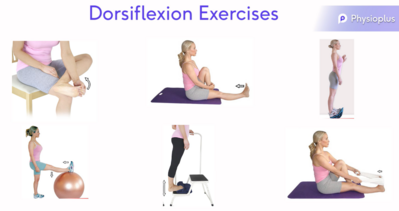
There are many reasons for seeing a Physiotherapist to aid with express range of move at a join. Range of motility therapy benefits include:
- Healing and recovery from soft tissue and joint lesions
- Maintaining existing joint and soft tissue mobility
- Minimizing the effects of contracture formation
- Preventing adhesions between myofascia
- Profitable neuromuscular reeducation
- Enhancing synovial movement [2].
Range of movement exercises can:
- Increase movement at a joint
- Increment the function of a joint, and the entire limb
- Improve movement efficiency
- Increase independence
- Decrease pain
- Improve and maintain joint integrity
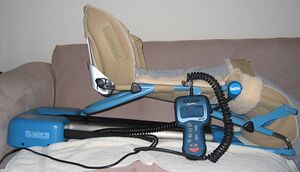
Regaining range of movement in a joint is ane of the first phases of injury rehabilitation. A physiotherapy assessment will exist performed prior to prescribing a range of movement exercises. The assessment looks at the present range and the quality of the motion.
- Joints maintain a balanced range of motility by regular use and stretching of the surrounding soft tissues. Just 10 minutes of stretching three times a week tin can help amend range of motility.
- Quite often strengthening exercises are prescribed alongside or presently after range of motility exercises as the increased movement at a joint without increasing the strength could cause a farther injury [9].
- If the goal is to increment performance, the combination of cream rolling followed past stretching (merely not vice versa) should exist favored compared to stretching alone.[10]
- Continuous Passive Movement Automobile (CPM) is also used to maintain and ameliorate ROM. Physiotherapists may employ this machine on mail service-operative patients (eg Total knee replacement patients). [11]
- In pediatrics, ROM exercises are used when all or some of the normal physical activities are not able to be completed due to the concrete status of the child. Attention is given to the joint not existence used through provision of active or passive ROM exercises. Passive ROM exercises tin be performed by a family fellow member or the healthcare provider. Active ROM exercises are performed by the child [12].
Resources [edit | edit source]
- Verywell Health
- Movement for Life Blog
- Man kinetics Blog
References [edit | edit source]
- ↑ Abu El Kasem ST, Aly SM, Kamel EM, Hussein HM. Normal active range of motion of lower extremity joints of the salubrious young adults in Cairo, Egypt. Bulletin of Kinesthesia of Concrete Therapy. 2020 Dec;25(1):1-7.
- ↑ two.0 2.1 Hudson S. Rehabilitation Methods and Modalities for the True cat. InHandbook of Veterinary Pain Management 2009 Jan 1 (pp. 538-577). Mosby. Available:https://www.sciencedirect.com/scientific discipline/article/pii/B9780323046794100280 (accessed 25.10.2021)
- ↑ Gajdosik RL, Bohannon RW. Clinical measurement of range of motion: review of goniometry emphasizing reliability and validity. Physical therapy 1987;67(12):1867-72.
- ↑ Gandbhir VN, Cunha B. Goniometer. Available: https://world wide web.ncbi.nlm.nih.gov/books/NBK558985/(accessed 25.10.2021)
- ↑ 5.0 5.1 Clarkson Hazel Thousand. Principles and Methods. Musculoskeletal Assessment - Joint Motion and Muscle testing. 3rd Edition. Philedelphia, USA. Lippincott Williams & Wilkins. 2013. p2-54.
- ↑ Wem ROM by joint Available:https://www.wikem.org/wiki/Range_of_motion_by_joint (accessed 25.10.2021)
- ↑ Magee DJ. Primary care assessment. In: Magee DJ, ed. Orthopedic Physical Assessment. sixth ed. St Louis, MO: Elsevier Saunders; 2014:chap 17 ''Limited range of motion
- ↑ Healthline What Is Limited Range of Move? Available:https://www.healthline.com/wellness/limited-range-of-motility (accessed 25.ten.2021)
- ↑ Physio great britain ROM exercises Available: https://www.physio.co.uk/treatments/physiotherapy/range-of-movement-exercises.php(accessed 25.10.2021)
- ↑ Konrad A, Nakamura Thou, Bernsteiner D, Tilp M. The accumulated furnishings of foam rolling combined with stretching on range of motion and physical performance: a systematic review and meta-analysis. Periodical of Sports Scientific discipline & Medicine. 2021 Sep;xx(iii):535.
- ↑ Samarpan Physiotherapy Clinic AHMEDABAD ROM Available: https://samarpanphysioclinic.com/ (accessed 25.ten.2021)
- ↑ Nurse Key. ROM exercises Available: https://nursekey.com/range-of-movement-exercises/(accessed 25.ten.2021)
Definition For Range Of Motion,
Source: https://www.physio-pedia.com/Range_of_Motion
Posted by: scottwhounces1938.blogspot.com


0 Response to "Definition For Range Of Motion"
Post a Comment